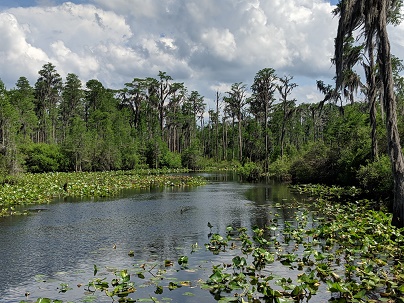In early 2000, I spent a two weeks in Korea, preaching and visiting friends and my parents (my father’s company had assigned him to a Korean factory making power plants near Pusan). I preached at a couple of churches, one of which had nearly 2000 in attendance at one service, which is the largest congregation to which I’ve preached. This tells of my last day in the country, as I took the train up the Korean peninsula to Seoul and then caught a plane for San Francisco.
Morning train to Seoul

It’s still dark when I board the morning express in Masan, heading toward Seoul. This far south, in this port and industrial city, the weather is chilly and wet but not really cold. I find my seat, stow my two bags overhead (a backpack and a suit bag) and push my jacket up against the window as a pillow. A pretty Korean woman sits next to me. She looks to be in her mid-20s and wears a dress and heels. We smile but when I speak, she shakes her head and says, “No English.”
Shortly afterwards, a whistle blows. The train jerks and my journey begins. I lay my jacket against the window, and my head upon it, alternating my time between looking and reading a book on Korean history and culture. Outside, fog mysteriously shrouds the streets lights.
Dark clouds hid the sunrise; all is gray. As we rush north toward Taegu City, we pass through many rural villages that seem the anti-thesis of Korea’s modern cities. Instead of concrete high-rise apartments, rural homes appear to have changed little over the past century. Most have small courtyards, protected by a high concrete walls. The house sits inside the courtyard, built out from the side of one of the walls. Smoke puffs from the clay pipes above these humble adobes. They use either coal, charcoal or wood fires to heat and to cook. All around the villages are fields for rice or vegetables, onions and cabbage and peppers. At Taegu, the woman next to me gets off.
After pulling out of Taegu, the train heads in a northwestwardly direction to Taejon City. This is mountainous country, but the hills are old and worn, like the Appalachians, not rugged and young like the Rockies. With the trees bare of leaves, I can make out the large nests of magpies.
Burial customs

Dotting the hills in the rural areas are many mounts representing burial sites. They place coffins on the ground. Stones and dirt are piled up around it. The government banned this practice because it takes up too much land in a country where land is precious. However, I’m told some people still bury their dead in this manner. Only today, they do it at night, in order not to attract attention.
Yongdong atrocity
Here, snow covers the ground. The roads are icy. At a crossing, just beyond the railroad gate, catch a glimpse of two cars in the ditch and a wrecker working to pull one back onto the highway. Along this section, we pass Yongdong. Near here, during a hasty retreat during the Korean War, scared American soldiers opened fire on civilians, killing many, in a tragedy of the war. Although I am not sure exactly where the site is at, I think about as it’s been in the news recently.
From Taejon, the train races north toward Seoul, traveling through a highly populated area that’s mostly industrial and suburban. High-rise apartments dot the landscape and there are many factories. The train pulls into the station at Seoul a few minutes early. I retrieve my bags and head up an escalator to the main station, worried how I’ll be able to find my ride with so many people. There, at the top of the escalator, I’m pleasantly surprised to see Chanrank and Chang waiting for me. They suggest we stop and have lunch at a café across from the college where Chanrank teaches.
Chop Head Hill

After lunch, as we have four hours before I need to be at the airport; Chang asks if I still want to visit Chop Head Hill. When I had arrived in Korea two weeks early, I had asked Chanrank and her husband about this place. I immediately worried that I had insulted them, but her husband told me more about the place. As he was required to be at the university where he taught this day, Chang came along to take us there. Yes,” I said. I would like an to visit the site.
The three of us seemed to be an odd pair to tour this site scared to Korean Catholics. Like me, Chanrak is Presbyterian. Chang is Buddhist. We wind through the narrow streets north of the Han River in Chang’s car till we finally arrive at the the infamous bluff overlooking the river.
For years, this hill was the site for executions, where the heads of the condemned rolled down into the river. One of the artifacts is a round stone, looking somewhat like a millstone, which was used in the beheadings. The condemned had a rope tied around his or her necks. The rope ran through the hole in the middle of the stone. One of the executors would pull the head of the condemn through the stone while the other used an ax to remove the head from the body.
In the middle of the 1860s, the French tried to gain a foothold in Korea. Sending a gunboat up the Han River, they shelled Seoul. The emperor, seeking a way to cleanse his country of the foreign devils, ask his shaman what to do. They suggested the execution of all Christians in Korea.
Catholic massacre in 1866
In 1866, the Korean emperor ordered the extermination of Korean Christians. At the time, almost all Korean Christians were Catholics. Priest from China converted most of these Christians. Members of churches were bound in chains and dragged across the nation to this place, where they were executed by beheading.
After a decade of tension, in the late 1870s, the French and Korea signed a treaty that guaranteed religious freedom for Korean citizens. In the aftermath of this treaty, Protestants missionaries—especially Presbyterians and Methodist—flooded into the country. In all of Asia, only the Philippines have more Christians than Korea. About 40% of the population claim to be Christian, half of which are Presbyterian. Another 40% of the population is Buddhist. On the hundred anniversary of the martyrdoms, the Catholic Church built a shrine in the honor of the martyrs. Known today as Chou Du San Martyrs’ Shrine or it’s English equivalent, “Chop Head Hill.”
Yongdo Full Gospel Church

As we still had two hours before we had to be at the airport, we swung by the Yongdo Full Gospel Church. An independent Pentecostal Church with roots in the Assembly of God, they claim to be the largest congregation in the world with 750,000 members. We quickly tour the church. Chang, a Buddhist, seems especially proud of the idea that his country has the world largest church. The sanctuary looks a look like a basketball area and seats nearly 20,000. Although large, I’m left to wonder where everyone worships. Even with their five worship services on Sunday, they would only be able to have 20% of their members member’s present.
After visiting the church, we rush to the airport. After checking bags, we have time for a cup of tea before I have to go through security. I shake Chang’s hand and hug Chanrank, then head through security. In an hour, I’m flying east and sleeping the night away on a Singapore Air flight to San Francisco.























 After a few hours of walking through the gardens and some time to write and read, I began my walk back along the river, watching several rowing crews practice on the water. Then I cut back over to Barton Springs Road, where I’m shocked at the line at Terry Black’s. I was told it was a 45-minute wait. If folks are waiting that long it must be good, I thought, and joined the line. It was. I had some of their pork and a brisket, both which were good. The banana pudding was passable.
After a few hours of walking through the gardens and some time to write and read, I began my walk back along the river, watching several rowing crews practice on the water. Then I cut back over to Barton Springs Road, where I’m shocked at the line at Terry Black’s. I was told it was a 45-minute wait. If folks are waiting that long it must be good, I thought, and joined the line. It was. I had some of their pork and a brisket, both which were good. The banana pudding was passable.

















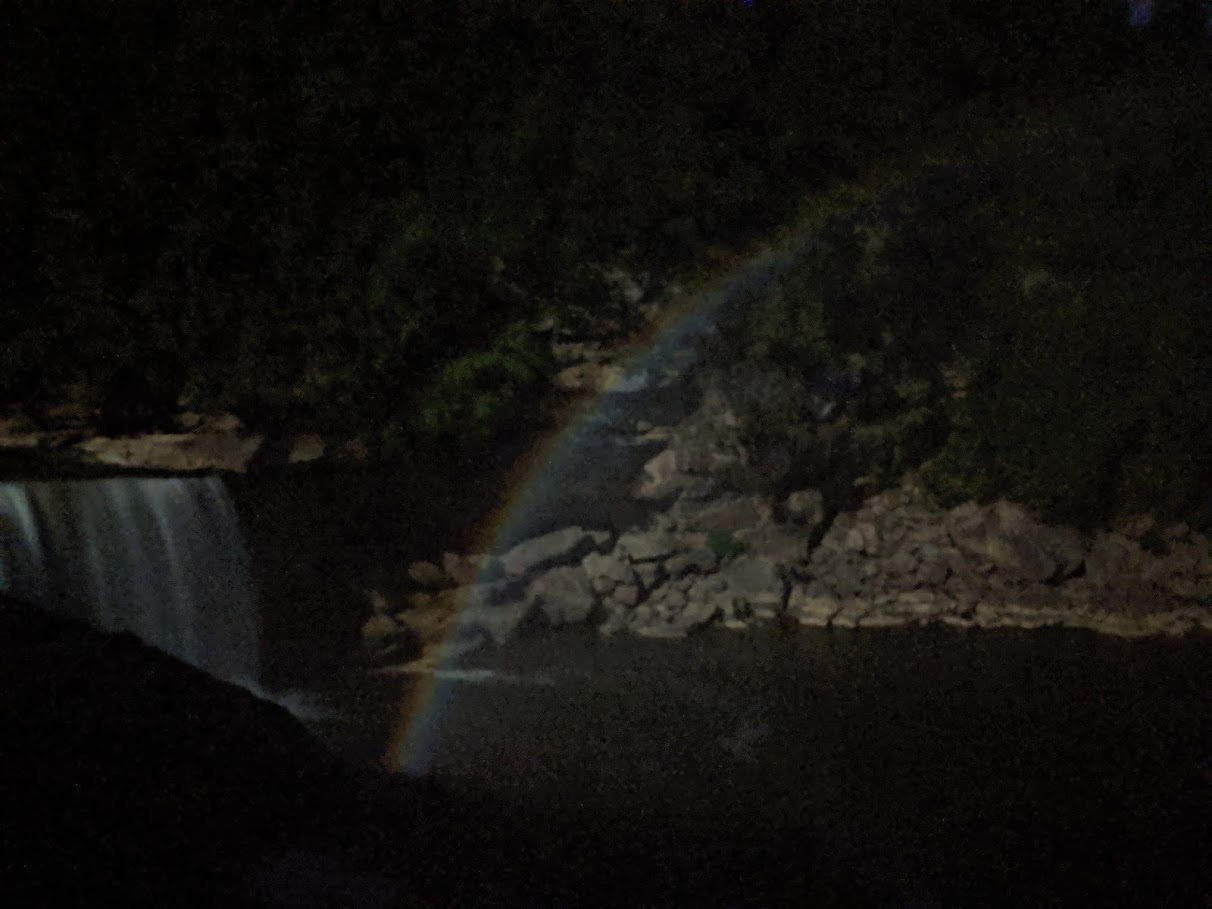
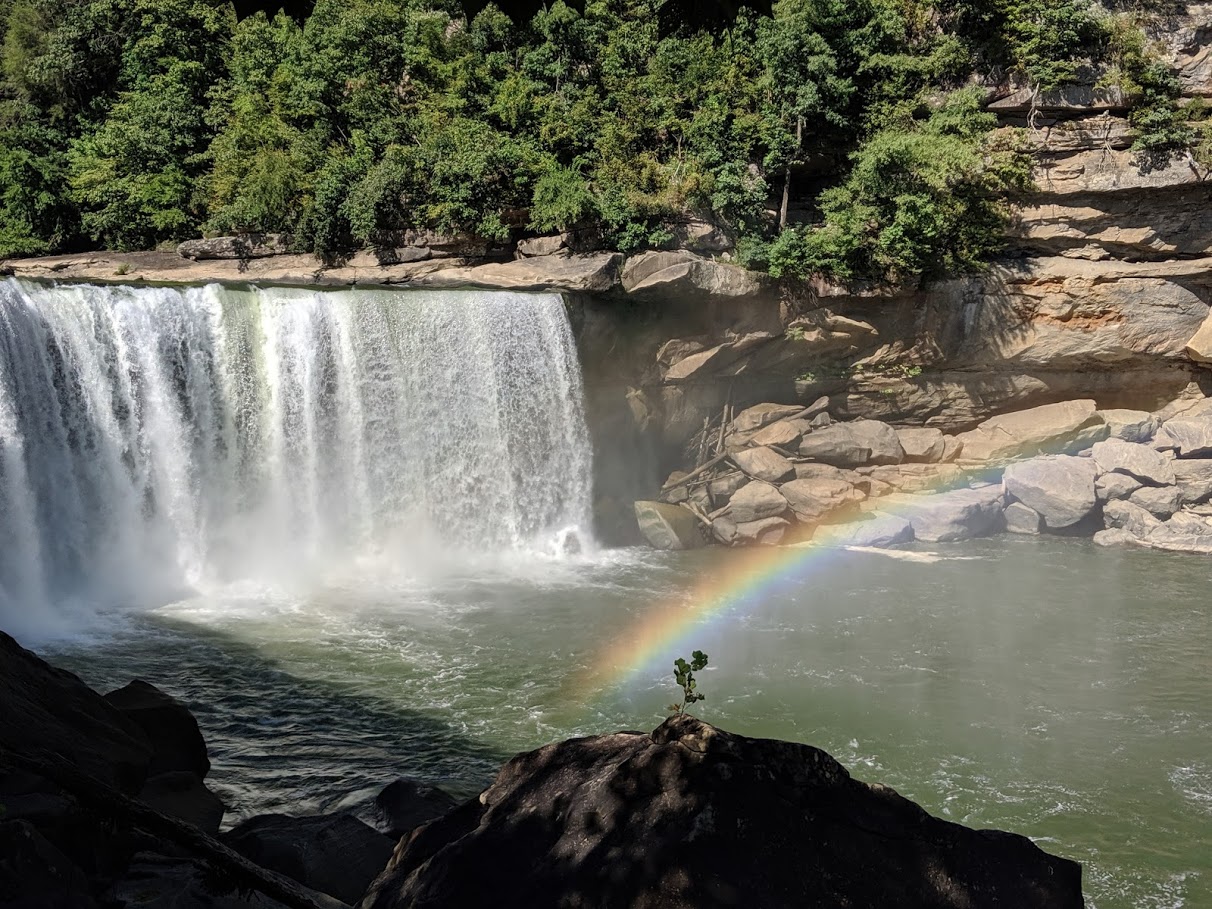
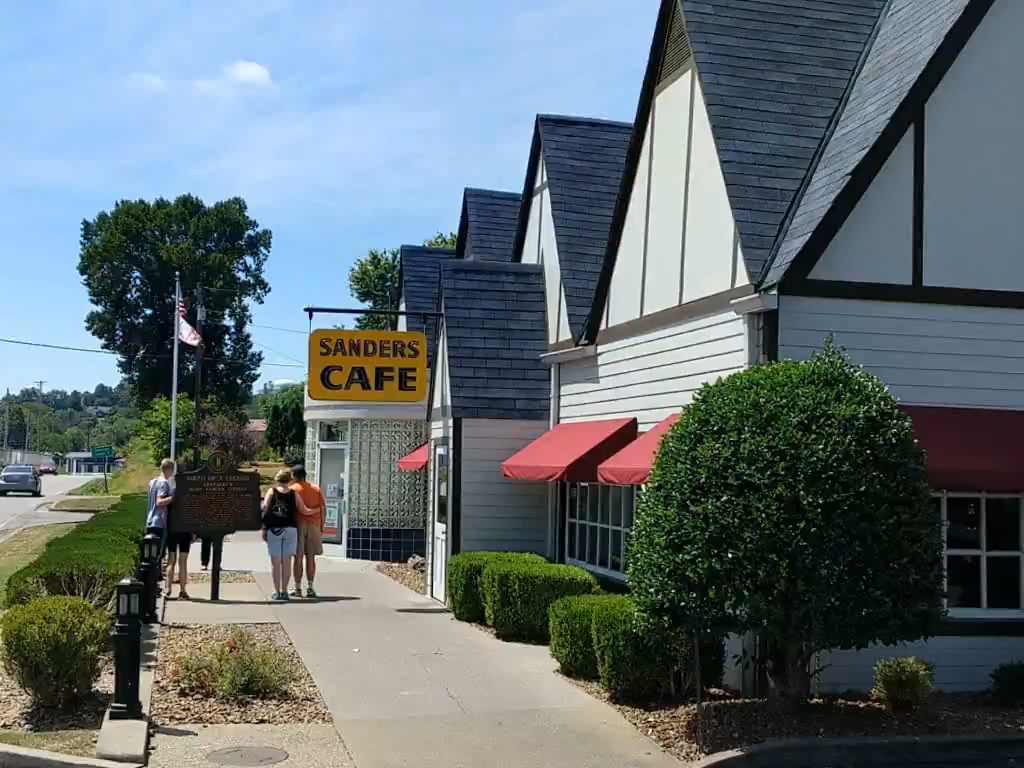
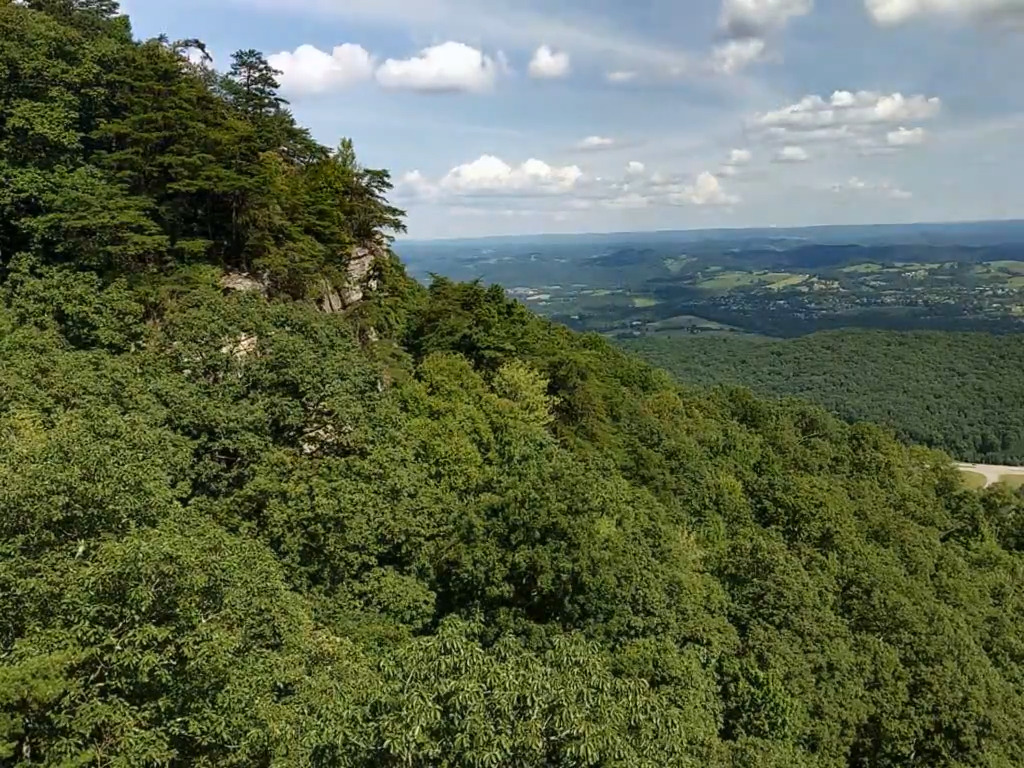
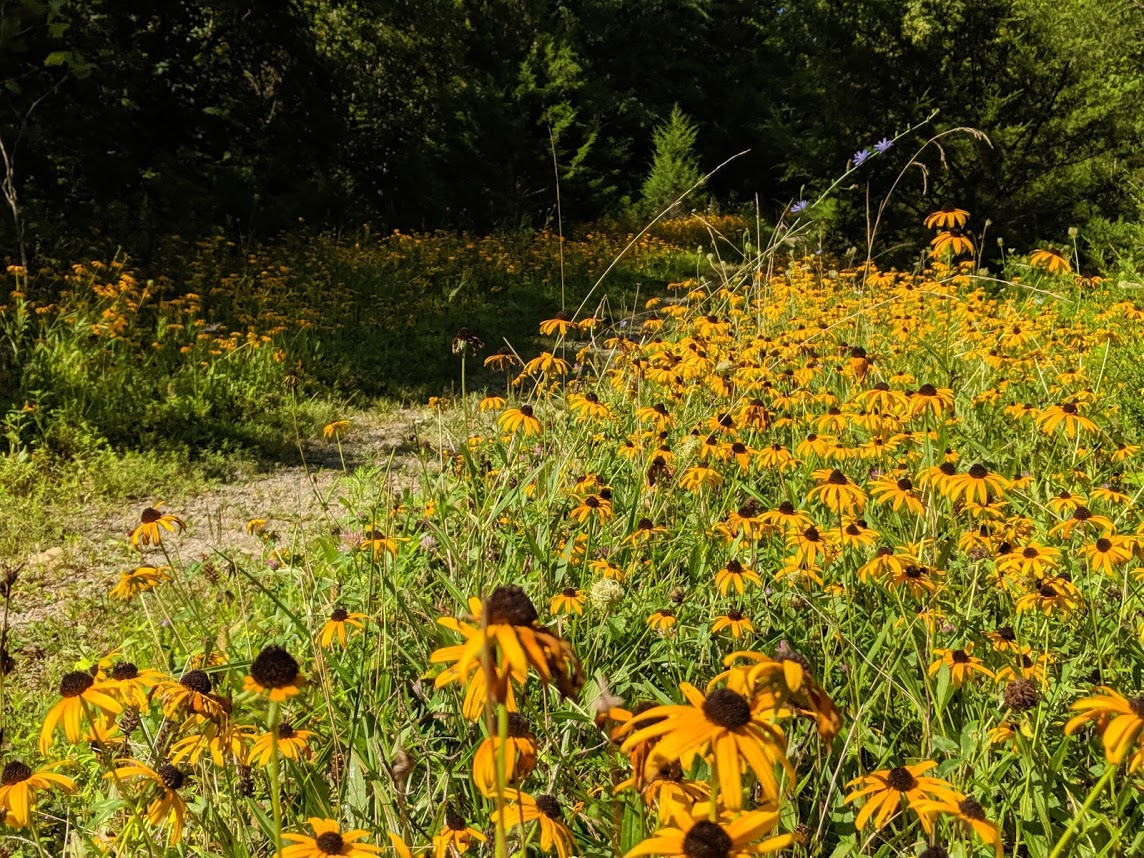
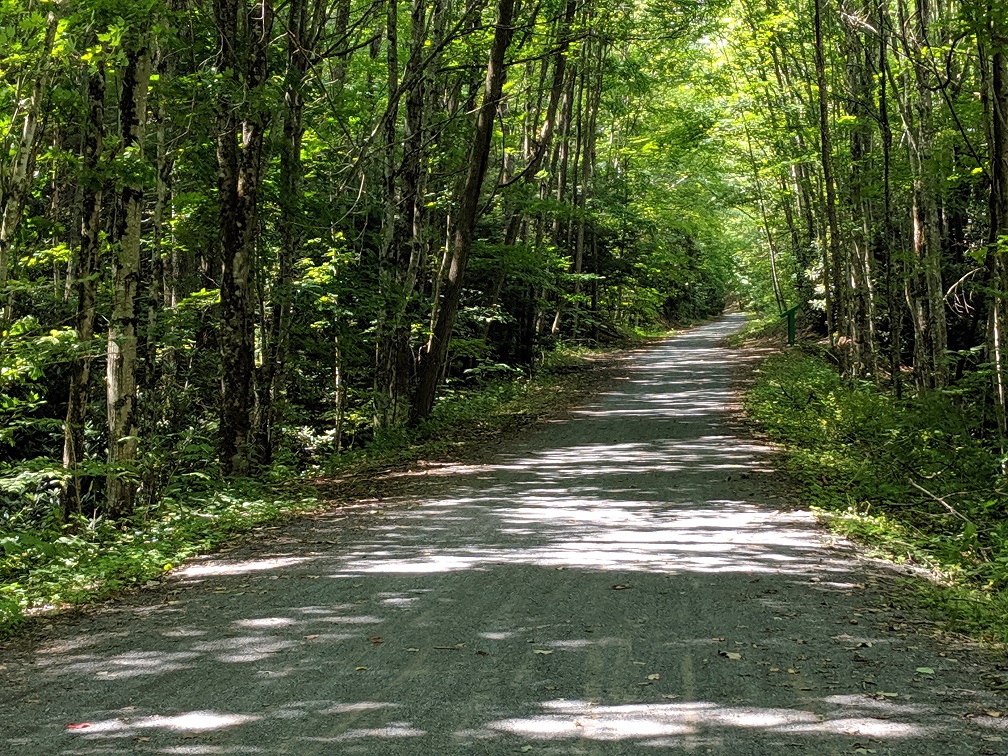
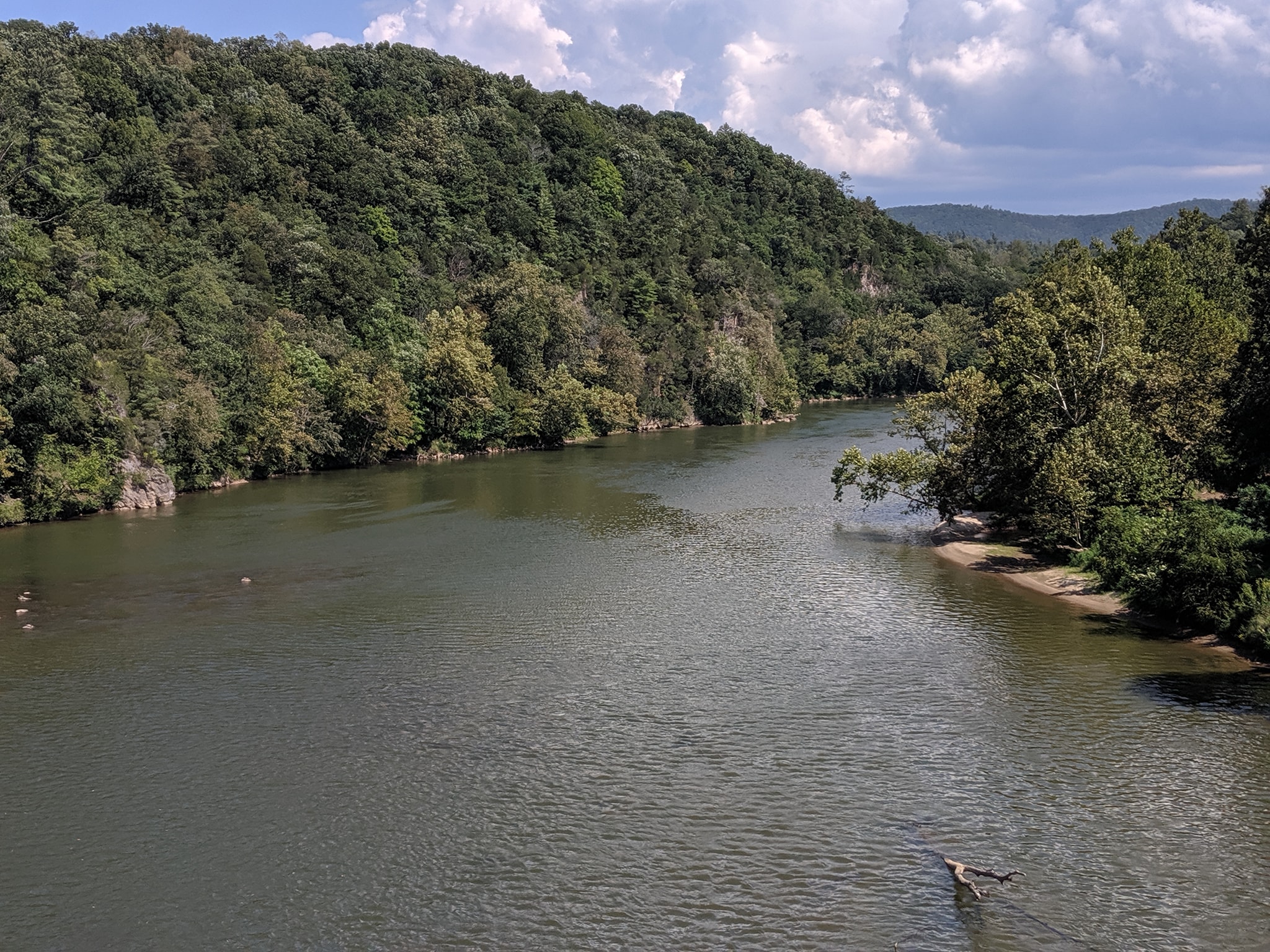
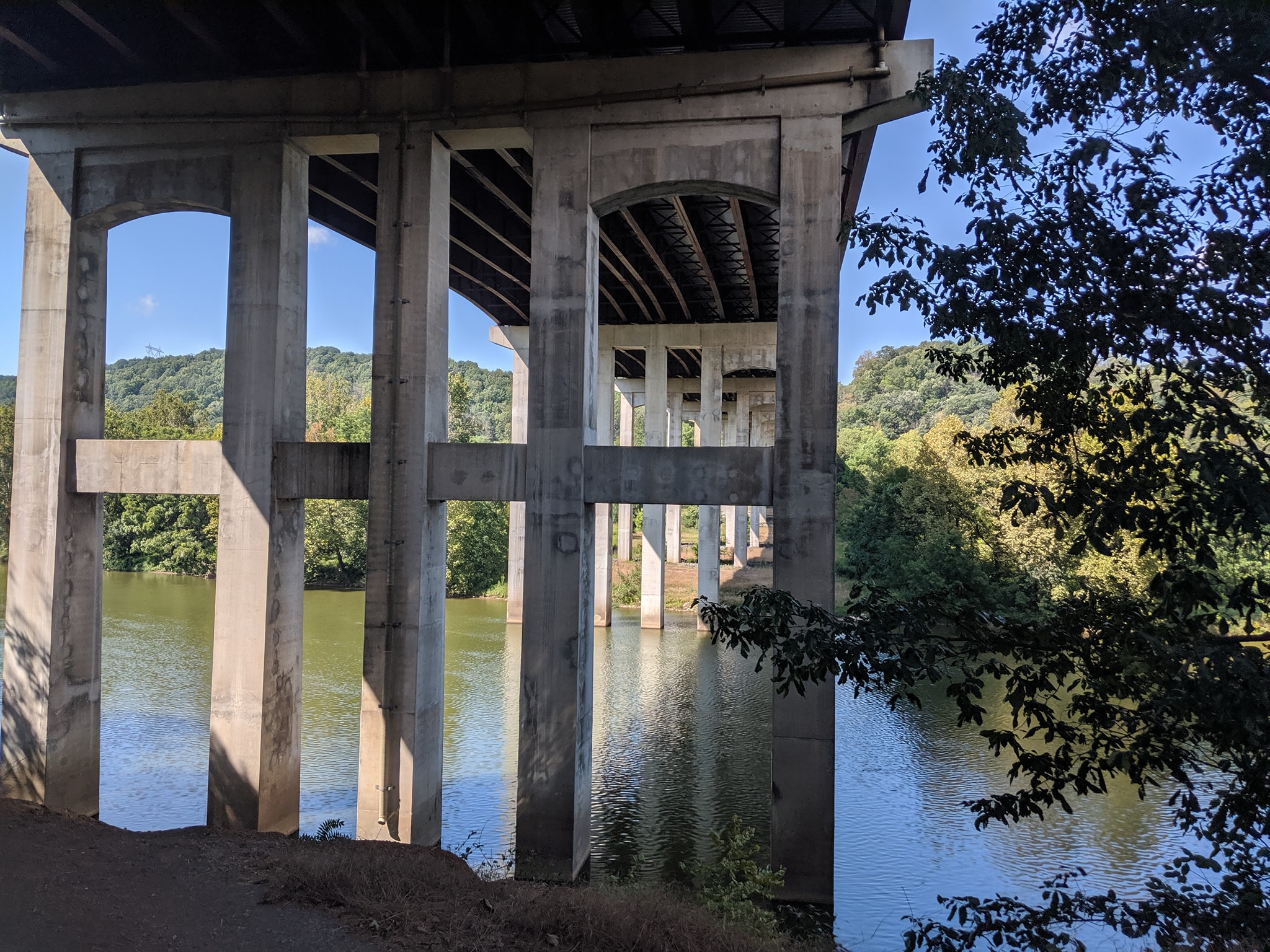
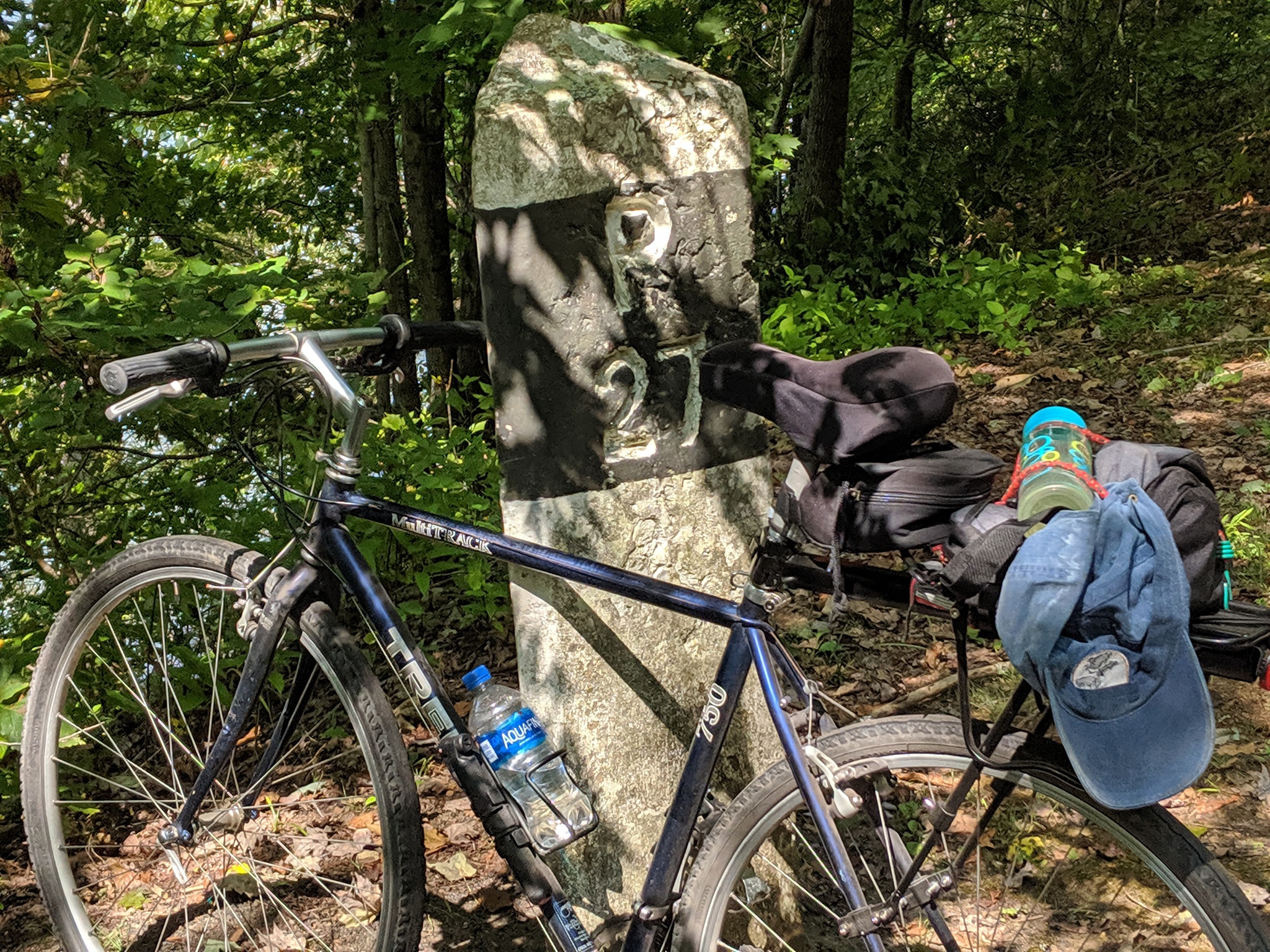
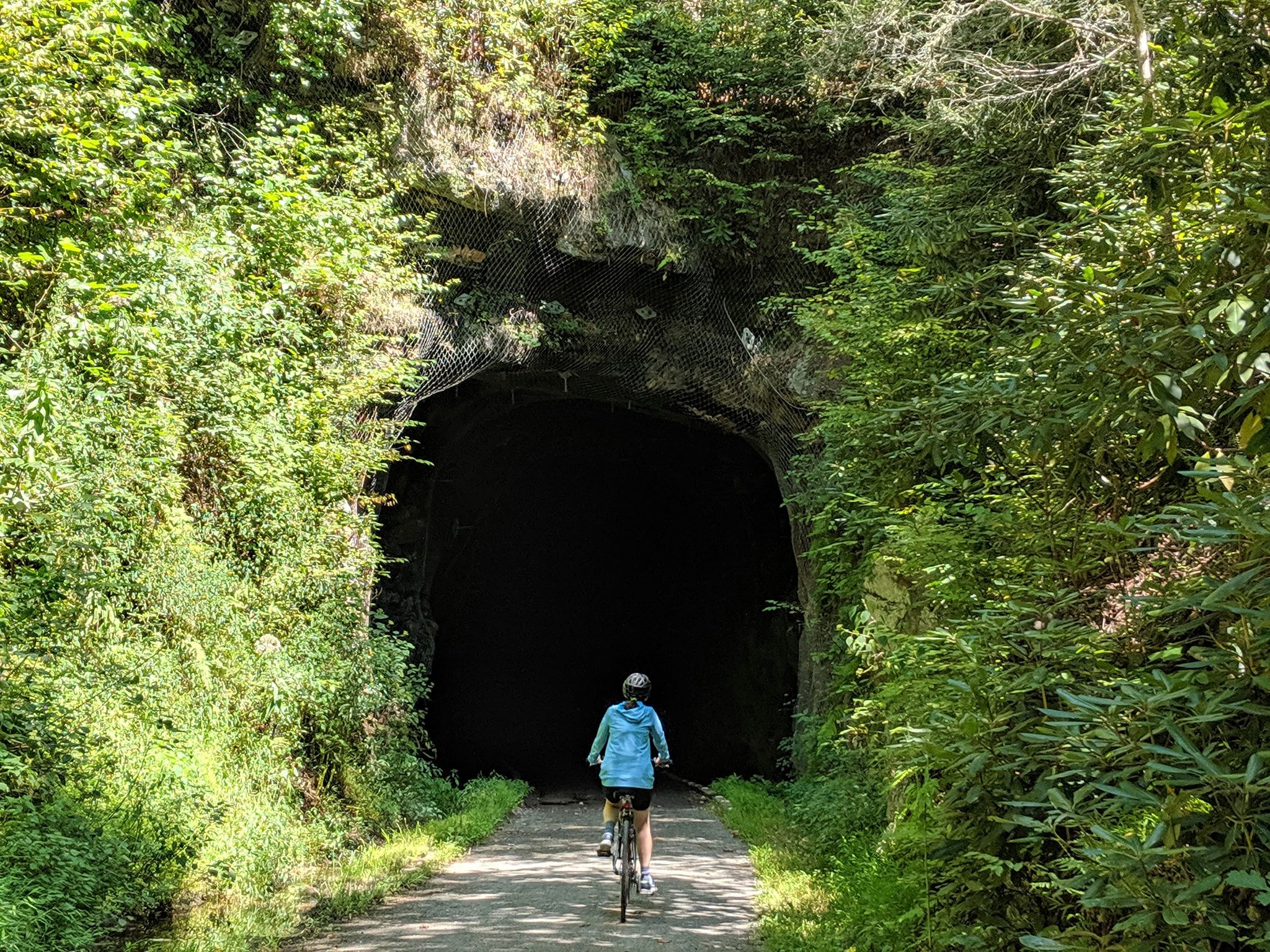
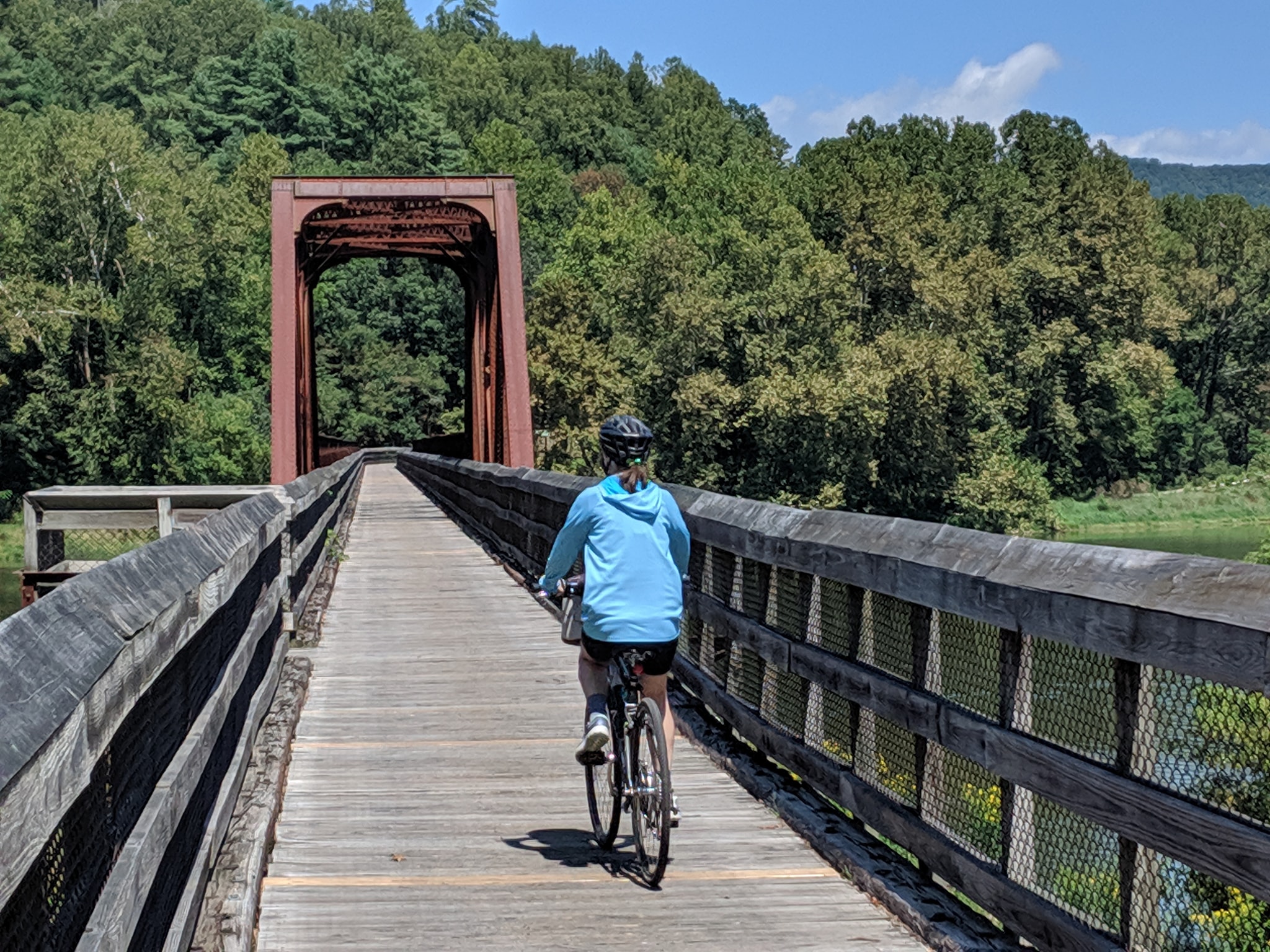
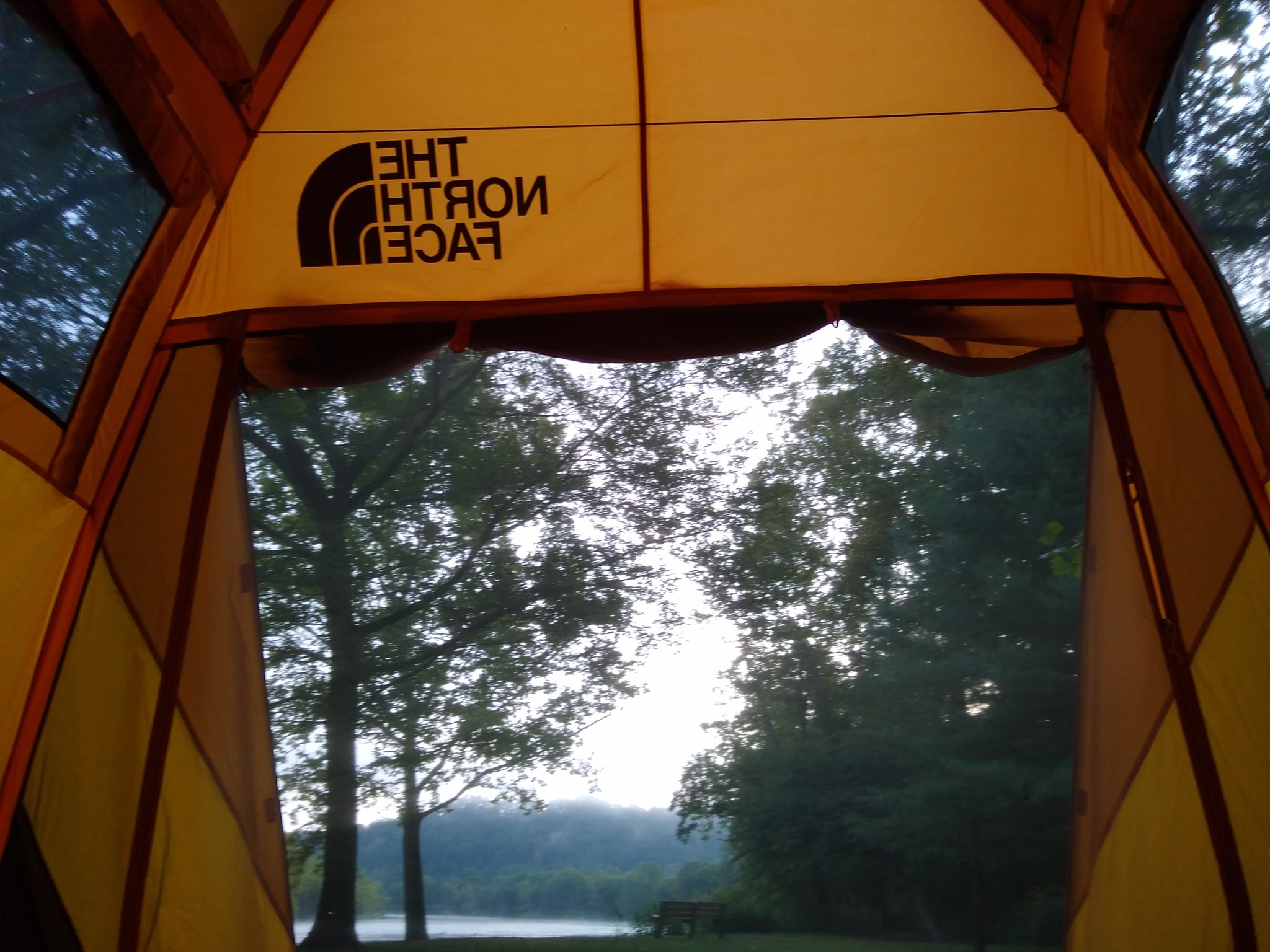 The campsites are rather expensive for pit toilets and no showers ($25/night), but we loved our site. It was just steps from the river and we had the place to ourselves. We slept to the sound of water running over rocks (augmented by the sounds of birds, frogs, insects, and the wind). It was a wonderful place to camp. And every evening, I took a swim in the river.
The campsites are rather expensive for pit toilets and no showers ($25/night), but we loved our site. It was just steps from the river and we had the place to ourselves. We slept to the sound of water running over rocks (augmented by the sounds of birds, frogs, insects, and the wind). It was a wonderful place to camp. And every evening, I took a swim in the river.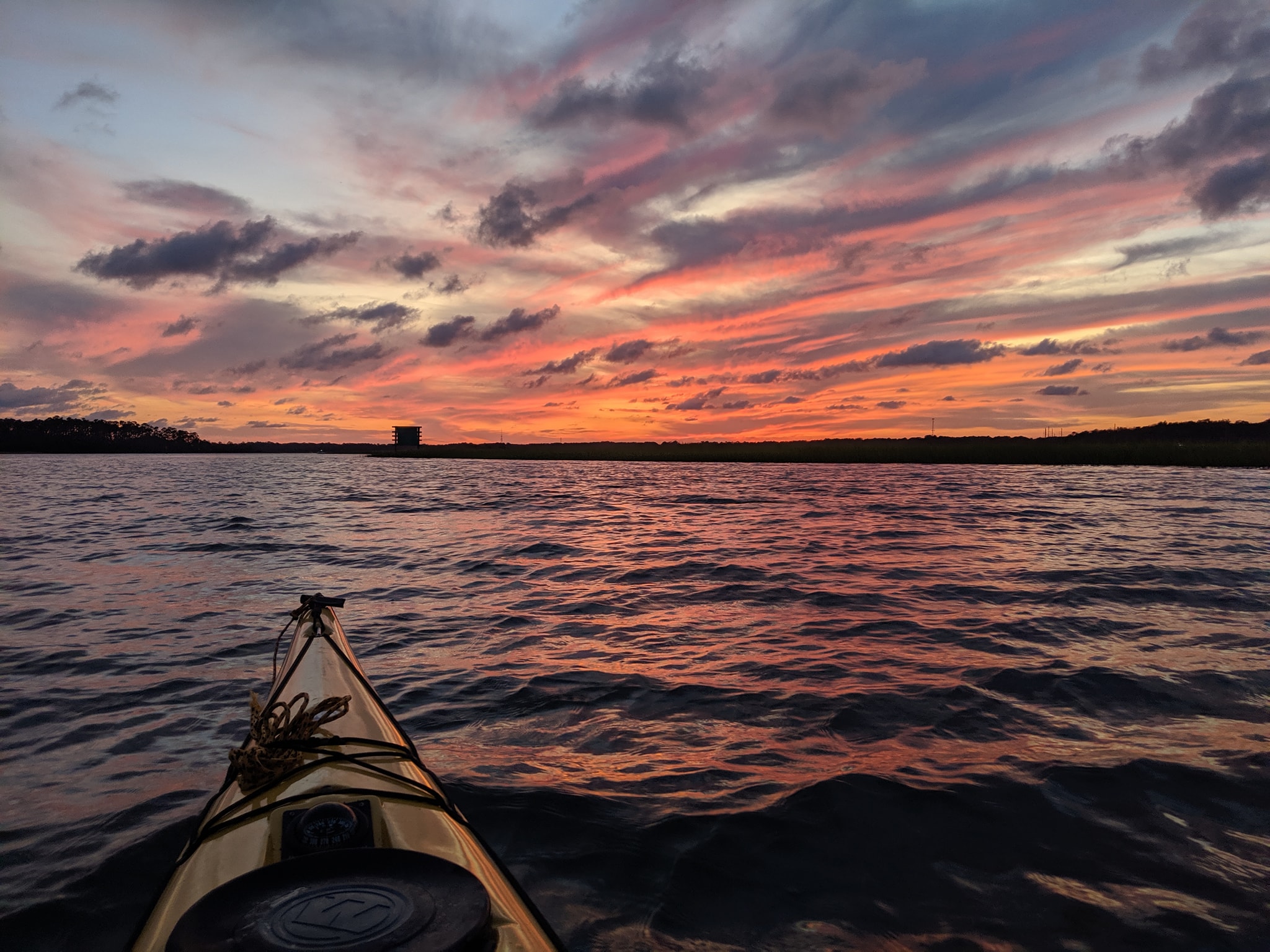 After getting back and having a hurricane threaten, another full moon came around. This time, at home and on a semi-clear evening, I made the best of it by paddling around Pigeon Island (about 6 miles). It was a magical evening starting with incredibly red skies and then the beauty of the moon.
After getting back and having a hurricane threaten, another full moon came around. This time, at home and on a semi-clear evening, I made the best of it by paddling around Pigeon Island (about 6 miles). It was a magical evening starting with incredibly red skies and then the beauty of the moon.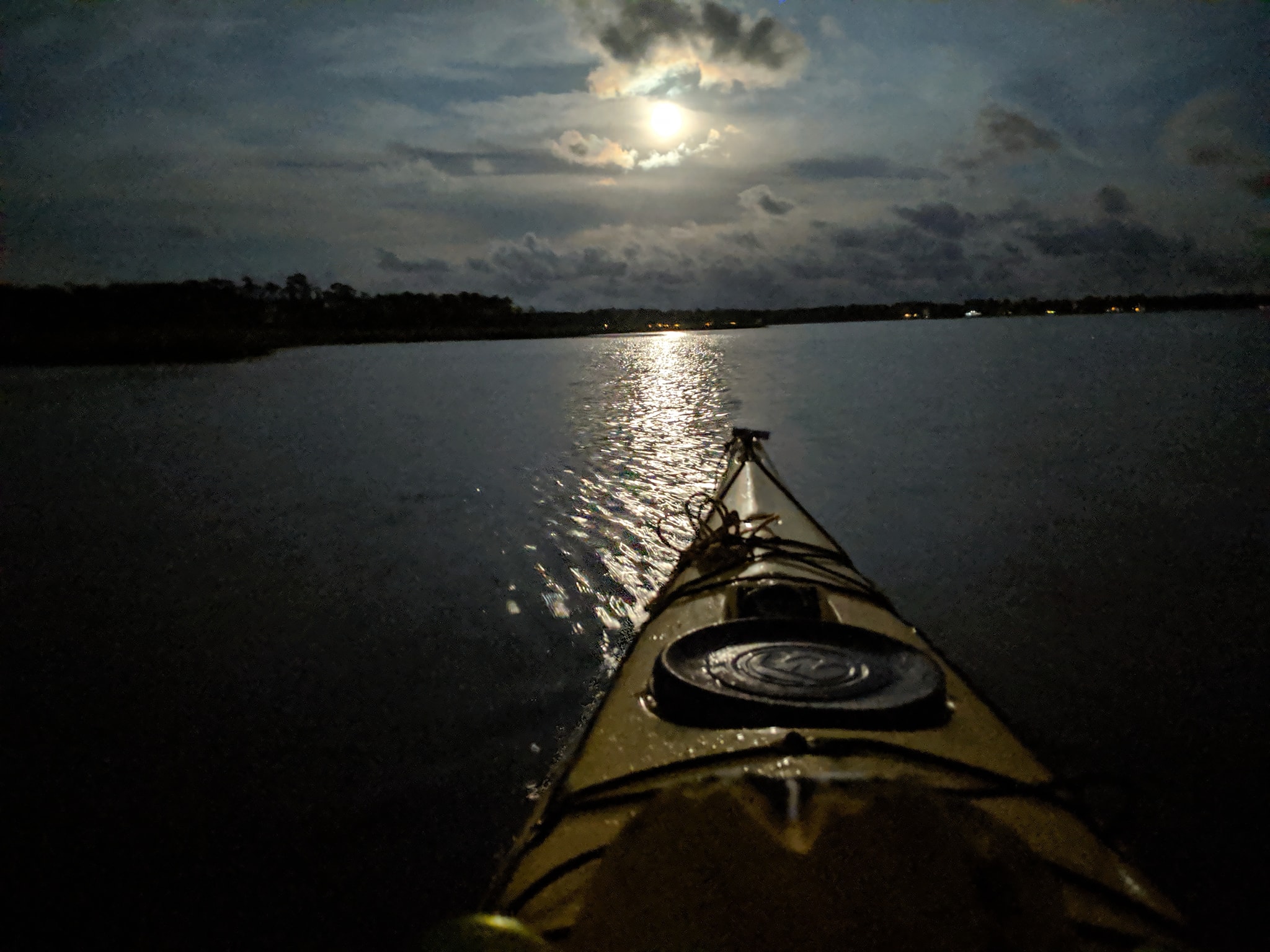
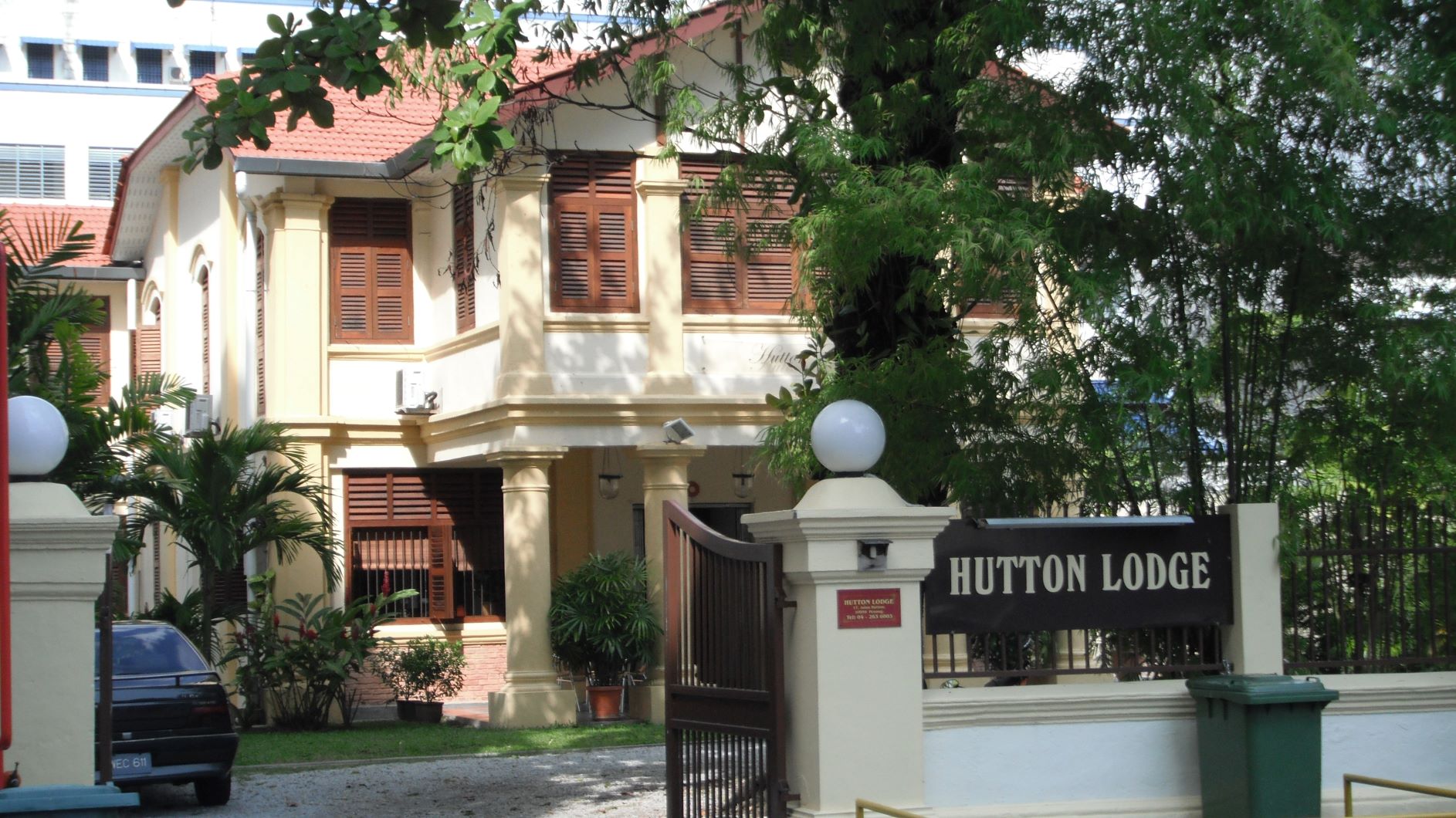
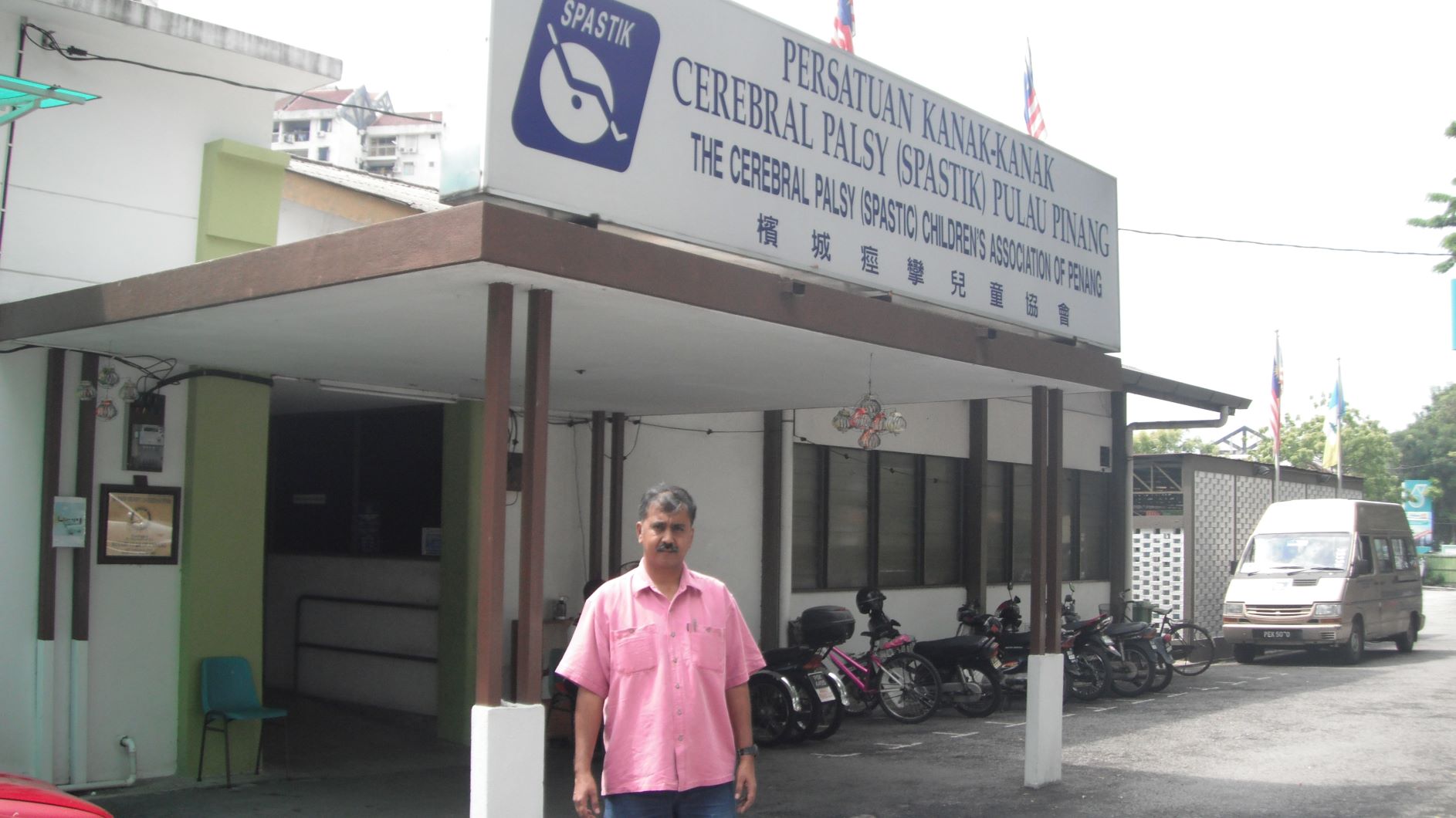
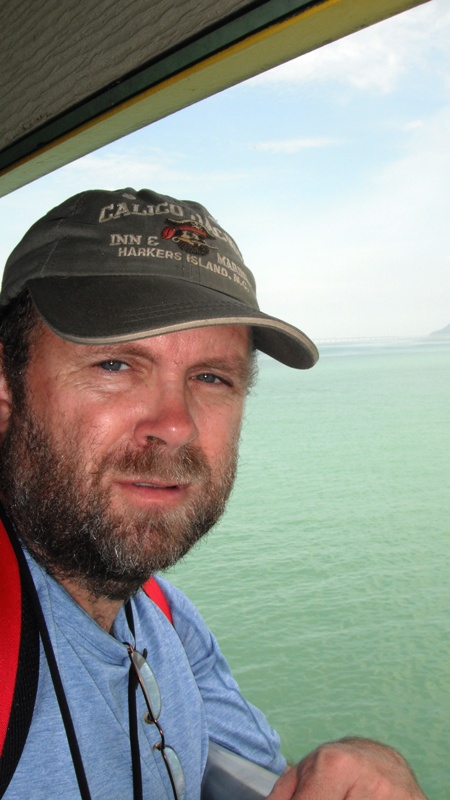
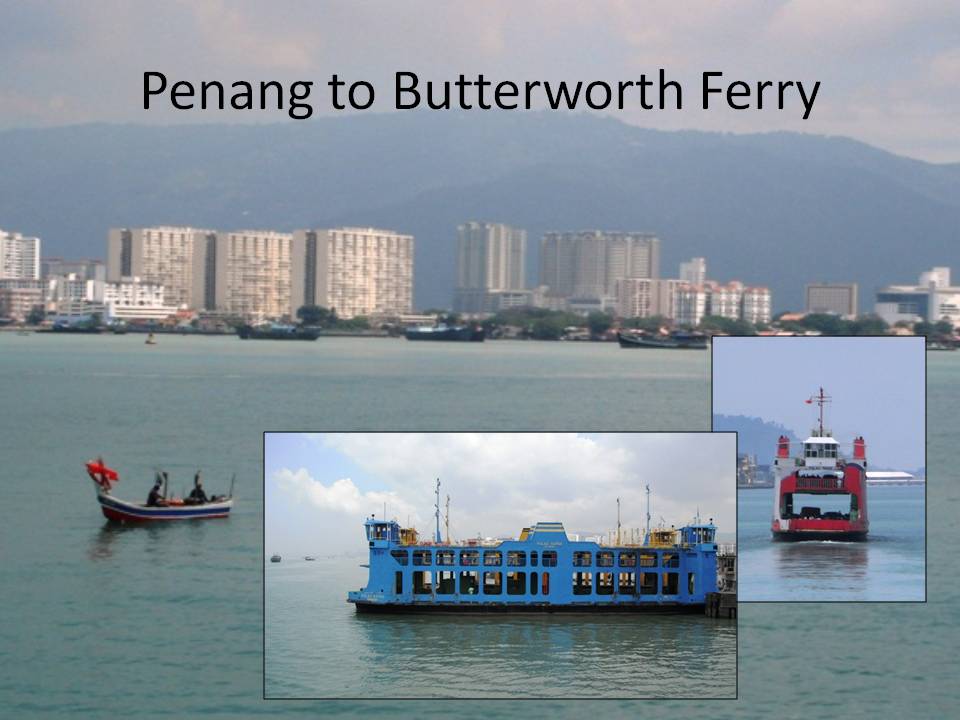
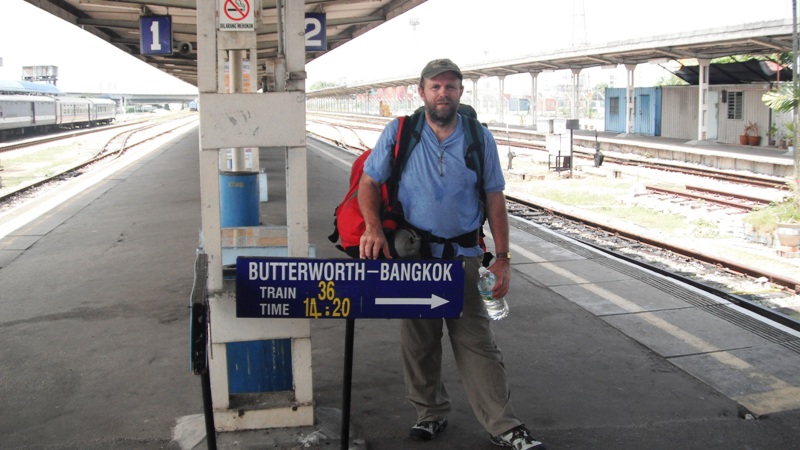
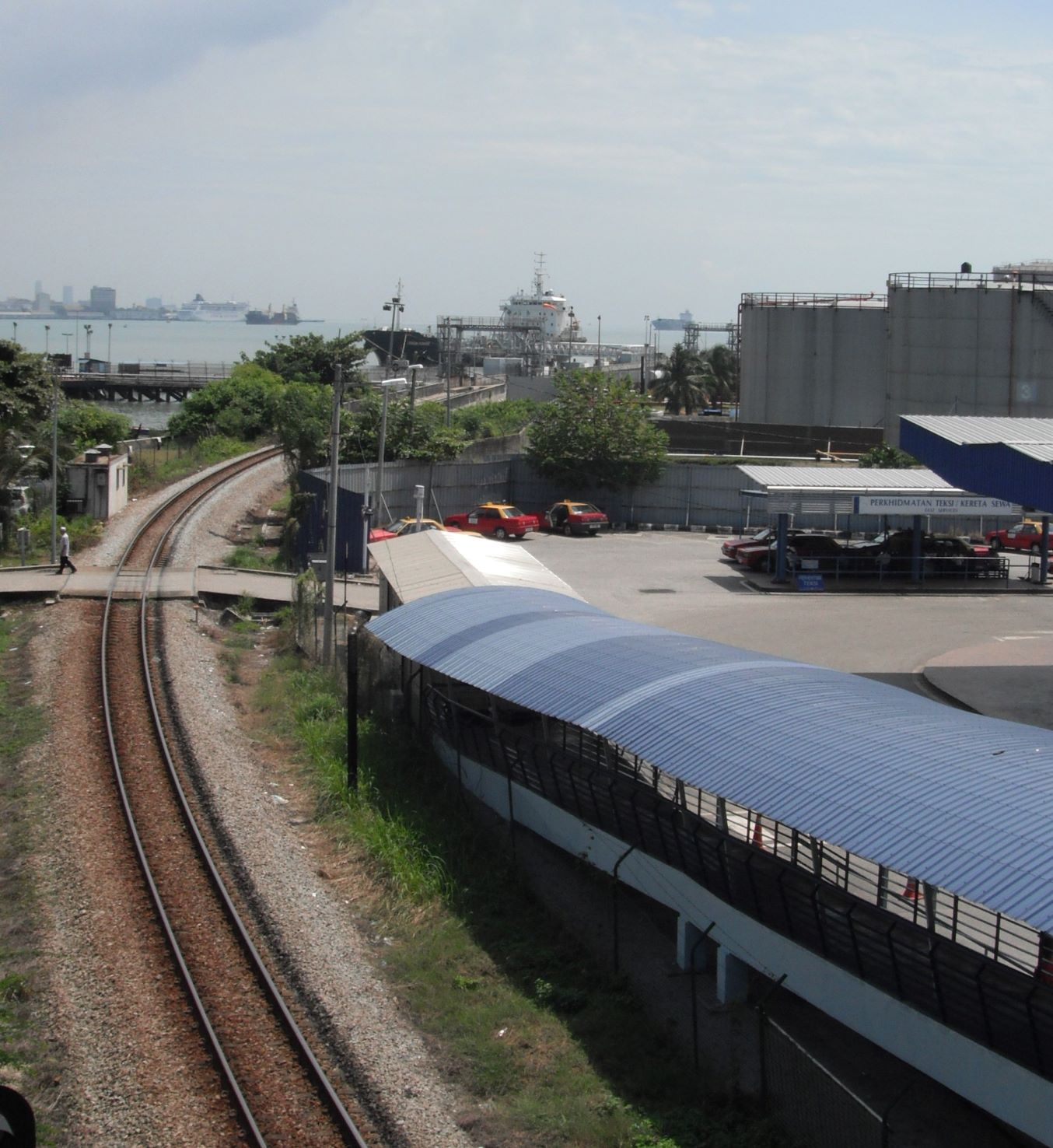
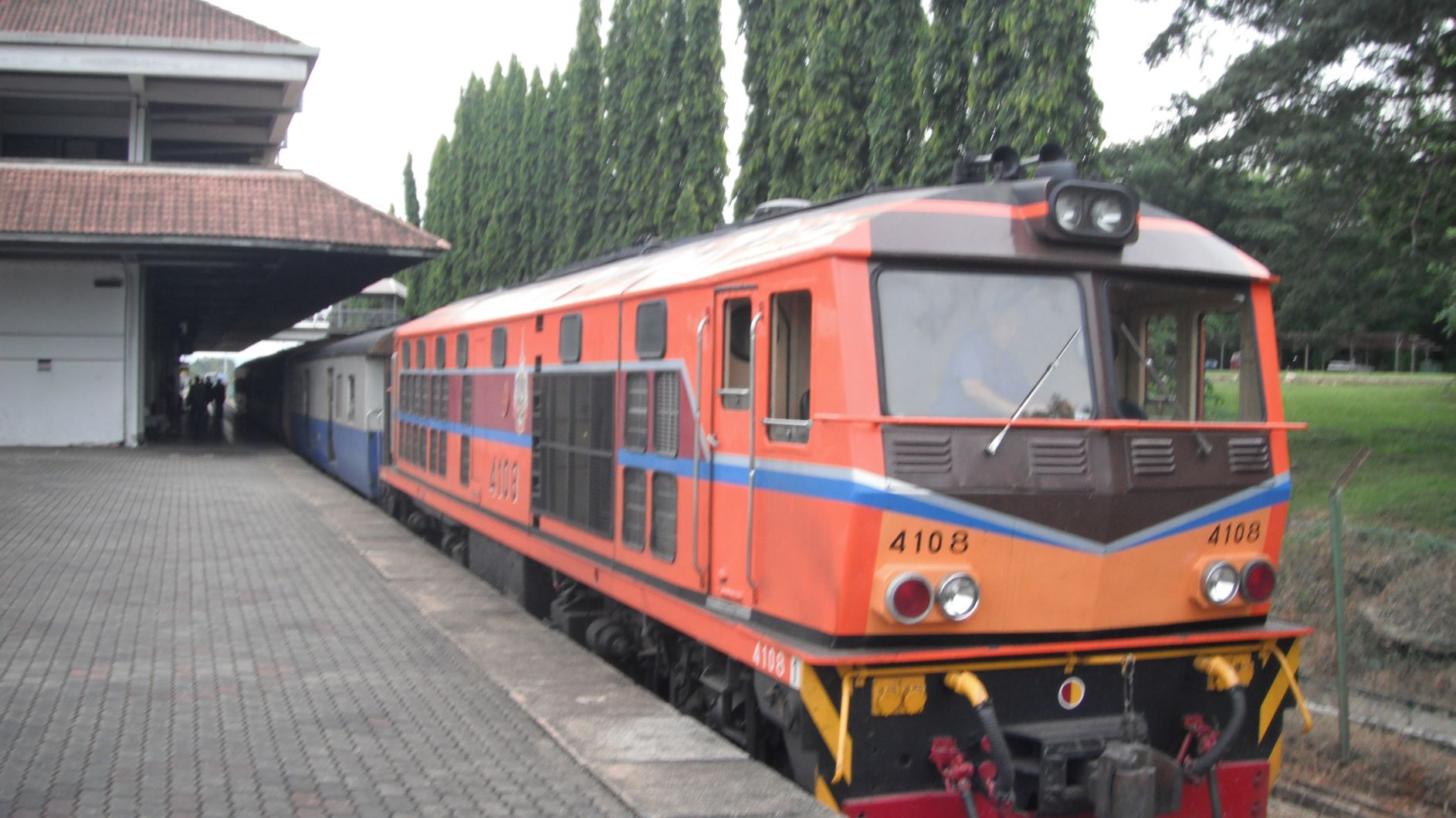
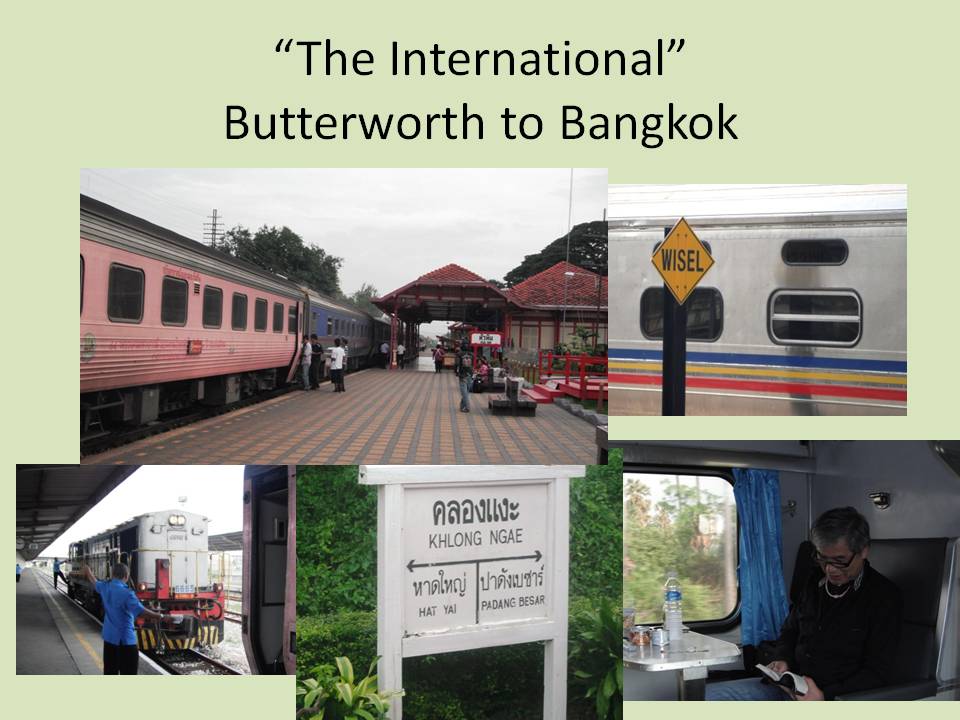
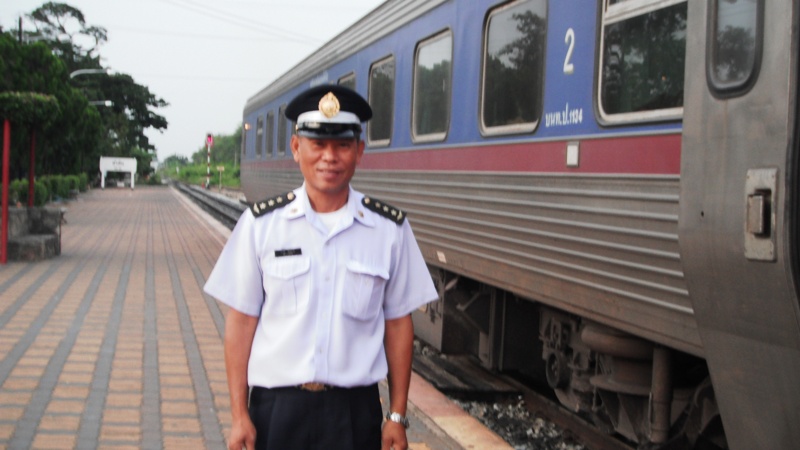
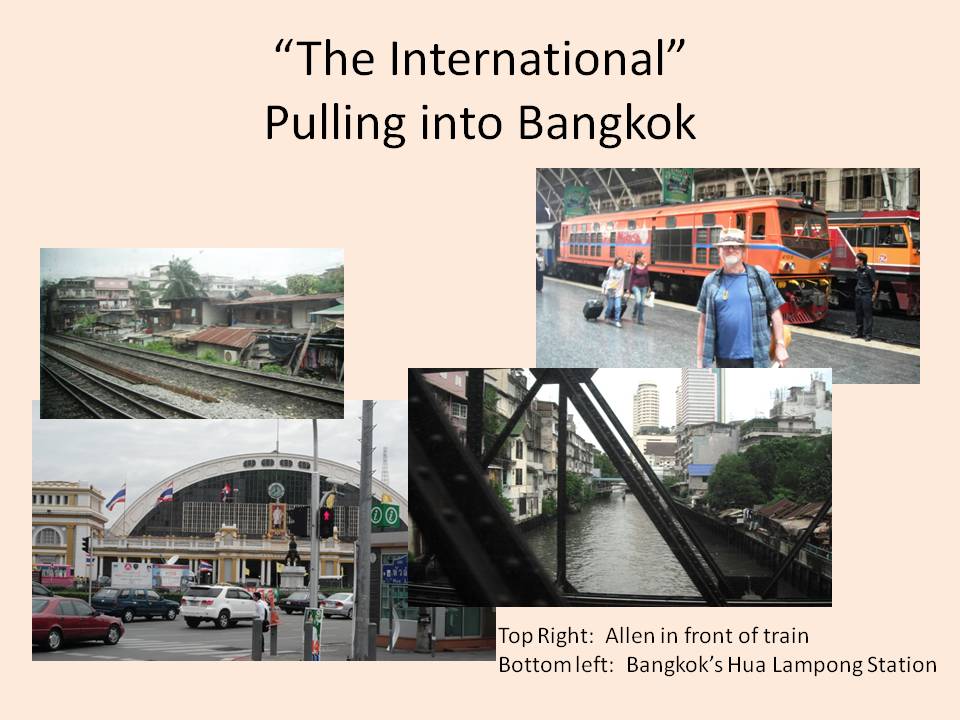
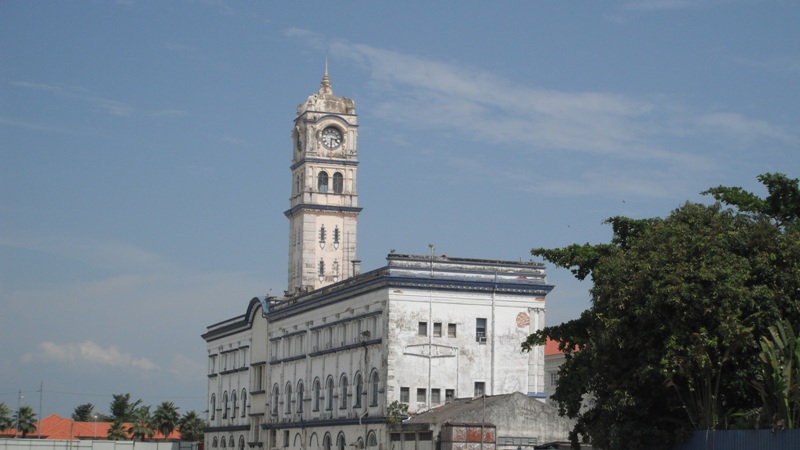
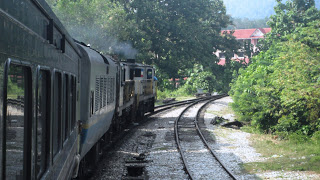
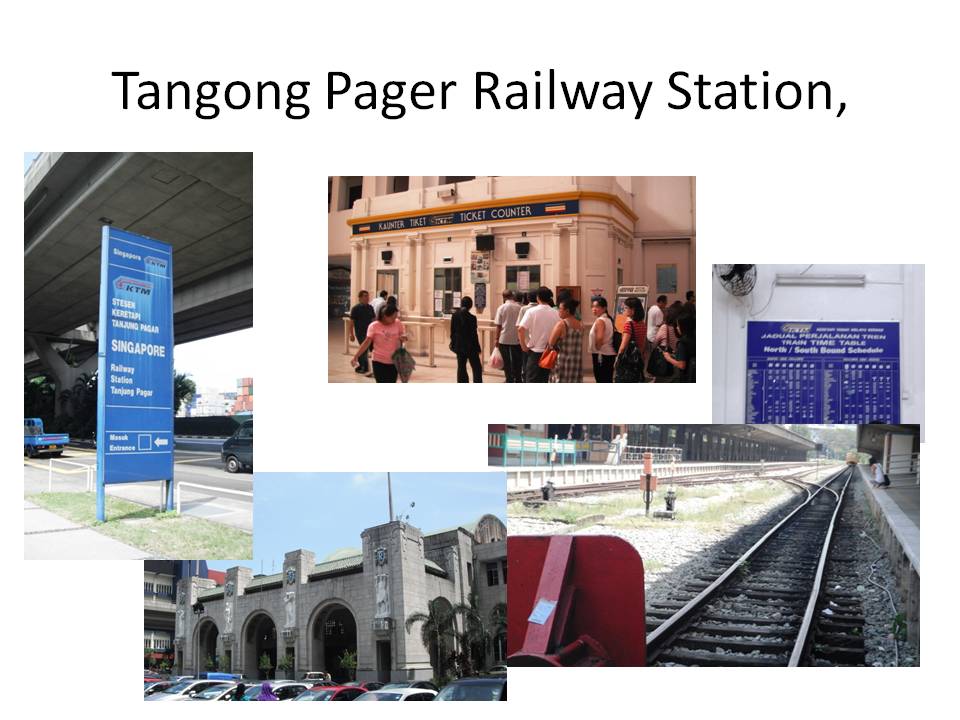
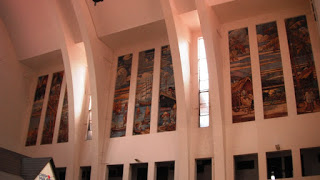
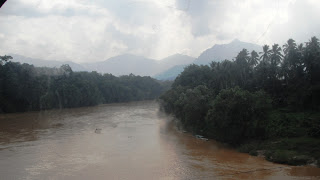
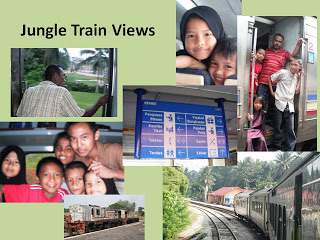
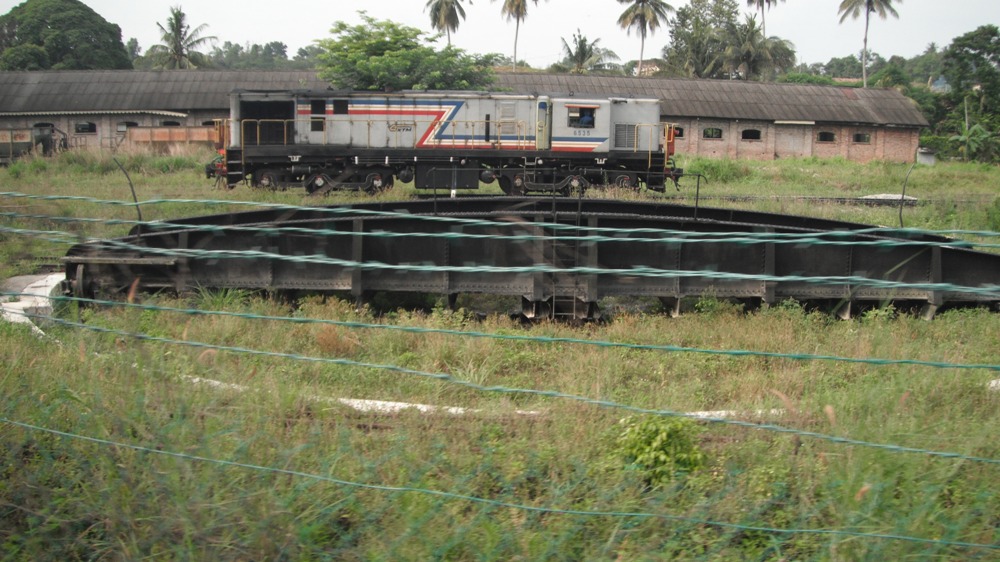
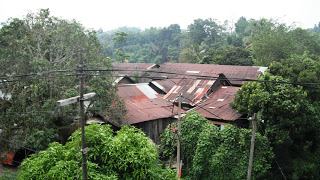
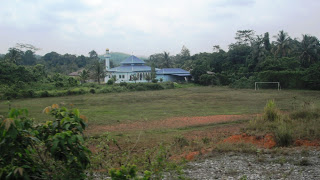
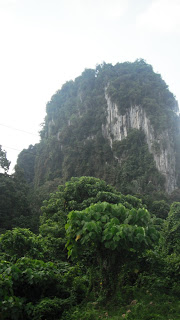
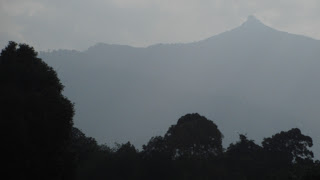




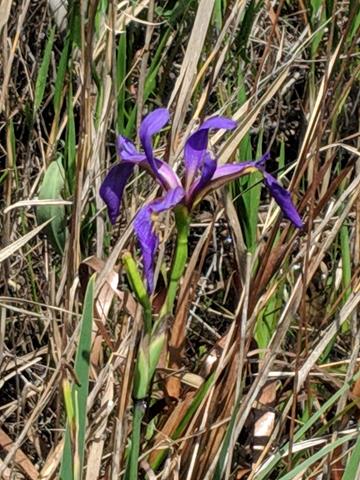




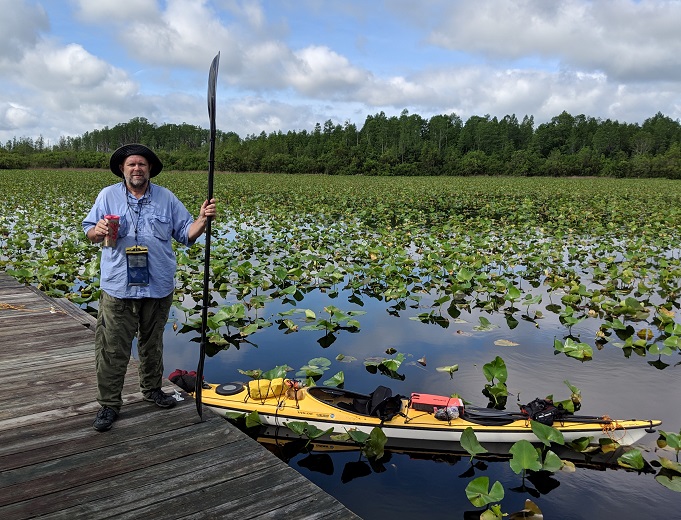
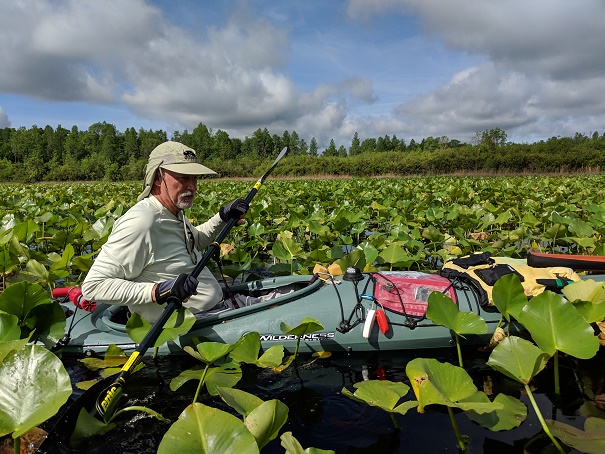
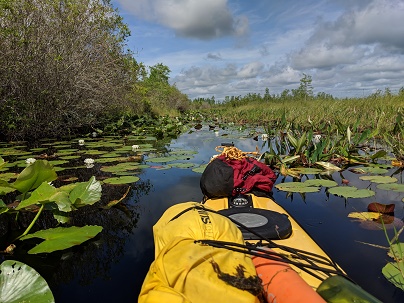
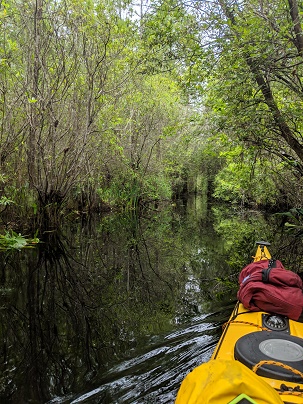
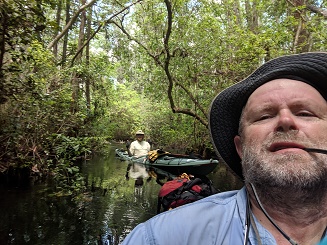
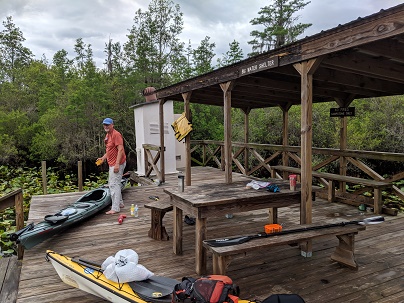
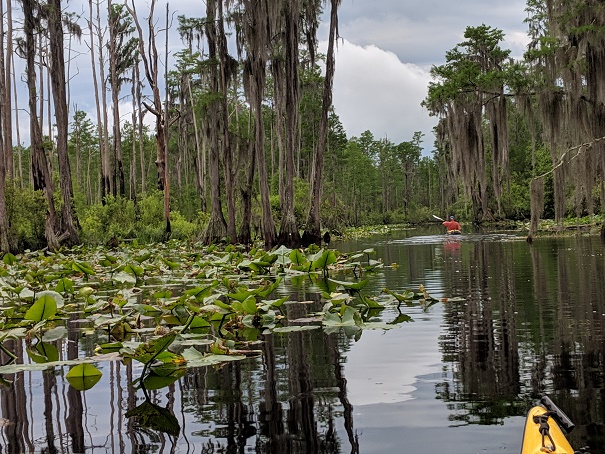
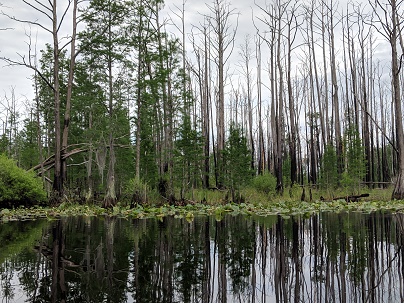
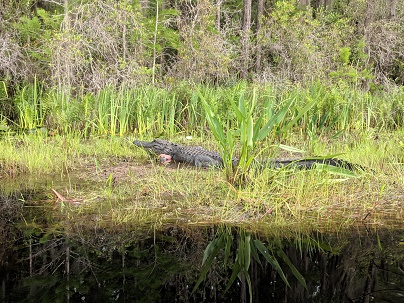
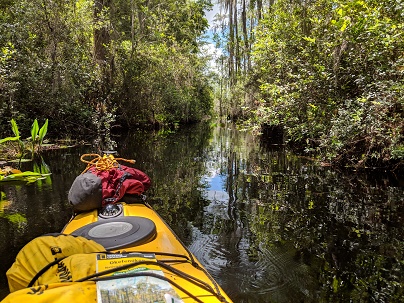
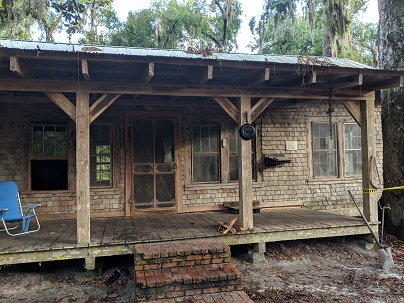
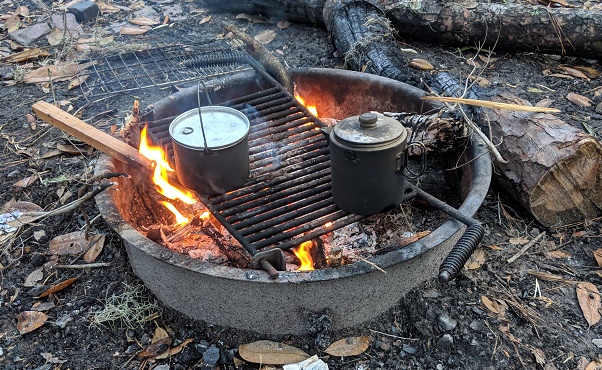 We eat lunch under the front porch during a downpour. A turkey and a fawn with spots make their way through our camp as we wait for the rain to clear. Later in the afternoon, when the storms have cleared, we move our kayaks, portaging over the quarter mile or so of the island, so that we’d be ready for the next day’s paddle. That evening, we cook over an open fire. The smoke helps deter the biting flies. We enjoy crackers and cheese, party nuts, along with some Johnny Walker Black Label. Again, I’m impressed with Gary’s beverage selection. I’m saving my cheap bourbon. Tomorrow, Gary will paddle out of the swamp while I will stay for another night.
We eat lunch under the front porch during a downpour. A turkey and a fawn with spots make their way through our camp as we wait for the rain to clear. Later in the afternoon, when the storms have cleared, we move our kayaks, portaging over the quarter mile or so of the island, so that we’d be ready for the next day’s paddle. That evening, we cook over an open fire. The smoke helps deter the biting flies. We enjoy crackers and cheese, party nuts, along with some Johnny Walker Black Label. Again, I’m impressed with Gary’s beverage selection. I’m saving my cheap bourbon. Tomorrow, Gary will paddle out of the swamp while I will stay for another night.